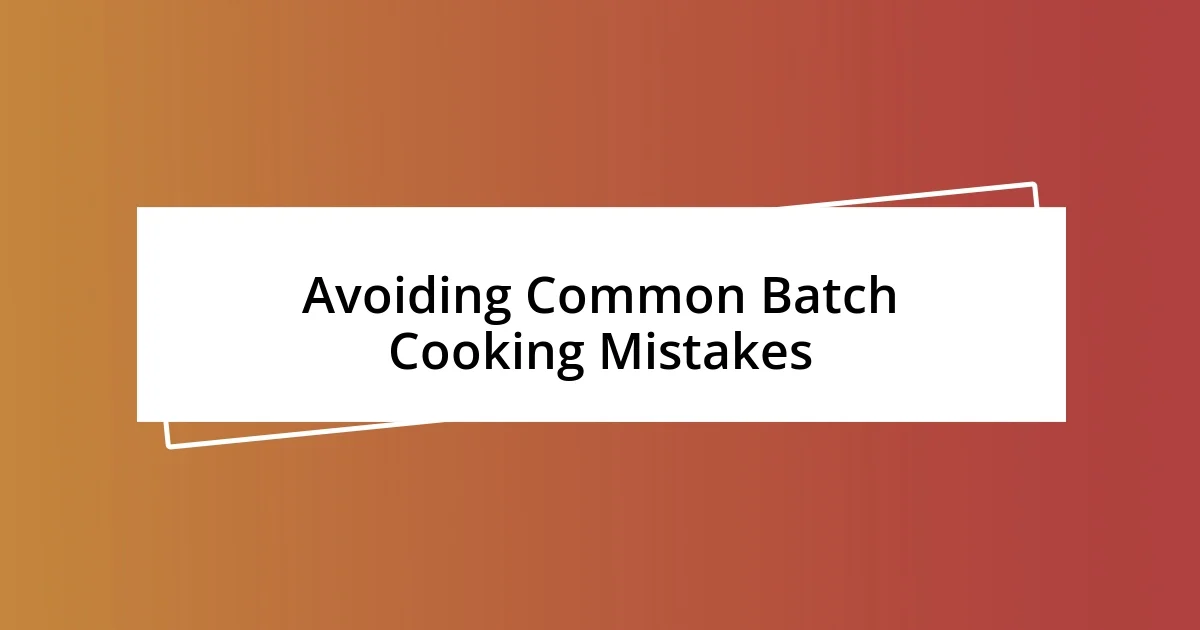Key takeaways:
- Batch cooking saves time and money by allowing meal preparation in advance and reducing impulse takeout orders.
- Essential tools like high-quality chef’s knives and food processors enhance the efficiency and enjoyment of batch cooking.
- Avoid common mistakes such as improper seasoning, overestimating portion sizes, and rushing the cooling and storage process for better meal outcomes.

Benefits of Cooking in Batches
Cooking in batches is a game-changer for saving time during busy weeks. I remember when my schedule felt overloaded, and after a long day, the thought of preparing dinner from scratch was overwhelming. By dedicating just a few hours during the weekend, I found that I could whip up a series of meals that carried me through the workweek, freeing up evenings for relaxation instead of frantic cooking.
Another significant benefit is the financial savings. When I started buying ingredients in bulk for batch cooking, I noticed a considerable drop in my grocery bills. Isn’t it satisfying to know you’re not just saving time but also making your wallet happy? Plus, with meals prepped ahead, I reduced our impulse takeout orders, which helped us cut down on unnecessary expenses.
Moreover, batch cooking allows for variety without the daily pressure. I often prepare a few different recipes and mix and match them throughout the week. It’s like having a mini buffet at home! How often have you searched the fridge only to find nothing appealing? With batch cooking, you’ll always have flavorful options waiting for you, making mealtime enjoyable rather than a chore.

Planning Your Batch Cooking Schedule
Planning your batch cooking schedule is crucial for maximizing efficiency and effectiveness. I like to take a quiet moment each week to sit down with my planner. I map out what meals I want to cook, considering ingredients that can be used across multiple dishes. It’s a great way to ensure nothing goes to waste and that I maintain variety in my meals.
When setting up your cooking schedule, I recommend designating a specific day or two dedicated to cooking. For me, that day is usually Sunday. This way, I have time to prepare, shop, and cook without feeling rushed. I always find that having a routine makes it easier to stick to batch cooking. What about you? Have you found a particular time that works well for your schedule?
Another thing I’ve learned is to prioritize meals that freeze well, such as soups and casseroles. This allows for flexibility during the week. You can pull out a thawed meal and have dinner ready in no time. It takes the dread out of cooking after a long day. Here’s a simple table to help you visually compare different approaches to batch cooking:
| Cooking Method | Prep Time |
|---|---|
| Making One Large Meal | 4 hours |
| Preparing Multiple Dishes | 6 hours |
| Freezing Individual Portions | 3 hours |
| Using Slow Cookers or Instant Pots | 5 hours |

Essential Tools for Batch Cooking
Essential Tools for Batch Cooking
Having the right tools can elevate your batch cooking experience immensely. I’ve often found myself in the kitchen, frustrated with subpar equipment, wishing I’d invested in better tools earlier. Good quality pans, a food processor, and storage containers can make all the difference in streamlining the process while ensuring delicious meals. When I upgraded my tools, the efficiency jumped tenfold, and I wondered why I hadn’t done so sooner.
Here’s a quick list of essential tools that I consider indispensable for batch cooking:
- High-Quality Chef’s Knife: A sturdy knife speeds up prep time and makes chopping feel effortless.
- Large Stockpot: Perfect for soups, stews, and boiling pasta in bulk.
- Food Processor: Ideal for quick chopping, blending sauces, or making dips.
- Slow Cooker/Instant Pot: Hands-off cooking for hearty meals with minimal oversight.
- Glass Storage Containers: They’re great for keeping meals fresh and are microwave-safe for easy reheating.
- Measuring Cups and Spoons: Consistency is key, especially when making large portions.
Over the years, I’ve learned that investing in quality tools isn’t just about performance; it’s also about the joy of cooking. I still remember a particularly busy week after I bought my first set of stackable storage containers. Organizing my meals felt like a revelation! Opening my fridge was no longer daunting; it felt like a mini masterpiece of culinary preparedness. The satisfaction of seeing a well-organized fridge full of delicious meals is truly rewarding.

Best Recipes for Batch Cooking
One of my go-to batch cooking recipes is a hearty vegetable soup. I can throw in whatever veggies I have on hand—like carrots, peas, and potatoes—along with some vegetable broth and spices. When I make this soup, I often let it simmer for a while, allowing the flavors to meld together beautifully. Plus, there’s something incredibly comforting about having a warm bowl of homemade soup available for those busy days. Have you ever experienced that warmth after a long day? It’s like a hug in a bowl.
Another favorite is a classic chicken casserole. I find that making several servings at once not only saves time later but also means I can experiment with different ingredients each time. Sometimes I add mushrooms, other times I toss in spinach or different cheeses. It keeps dinner interesting! I remember the first time I served it to friends; their expressions—surprise and delight—when they realized I had made it in bulk made me feel incredibly accomplished. It’s satisfying to know you can whip up something delicious without the stress of last-minute cooking, isn’t it?
Lastly, chili is a fantastic batch cooking recipe that ticks all the boxes. In my experience, you can easily make a large pot and let it cook low and slow. It’s perfect for freezing, and it actually gets better with time as the flavors develop. Sometimes, I’ll even host a chili night with friends where we compare recipes; nothing beats sharing a hearty meal together while showcasing what we’ve each created. How do you feel about cooking while sharing good times with loved ones? To me, it’s truly the heart of batch cooking.

Reheating Techniques for Batch Food
When it comes to reheating batch food, I swear by the oven for dishes like casseroles. Just the other day, I pulled out a leftover lasagna, and while it was tempting to just pop it in the microwave, I decided to reheat it in the oven instead. The crispy edges and bubbling cheese took me right back to when I first made it. It made me wonder—don’t we all deserve that little extra effort for a meal that’s meant to remind us of home?
Reheating soups and stews is straightforward with a stovetop or microwave, but I like to go the extra mile. I add a splash of fresh broth or water to refresh flavors before heating. The aroma that fills my kitchen? Pure bliss! It’s funny how a simple step can transform a tired dish into something that feels brand new. Have you noticed how a little aroma can instantly bring memories flooding back? It makes you appreciate that meal all over again.
Of course, if you’re dealing with rice or grains, tossing them in a pan with a dash of oil can work wonders. I learned this trick during a busy week when I prepped a big batch of quinoa. Instead of a bland reheating duty, giving it a quick fry with a splash of soy sauce brought it back to life—and my taste buds danced with joy! Isn’t it amazing how a little creativity in the kitchen can turn a mundane task into something delightful?

Avoiding Common Batch Cooking Mistakes
One common mistake in batch cooking that I’ve fallen for is not properly seasoning the food as it cooks. I remember making a big pot of curry and thinking I could just sprinkle some salt and spices at the end. Alas, it tasted flat! It really drove home the importance of layering flavors throughout the cooking process. Have you ever tasted a dish that felt incomplete? It’s a gentle reminder that cooking is a journey of flavors.
Another issue is overestimating portion sizes. Early on, I was so enthusiastic about my batch cooking that I made enormous quantities only to find I had too much for one person. I ended up giving meals away, which was nice, but it felt like a waste. Now, I focus on creating enough to last without overwhelming my fridge. Have you found yourself with leftovers you didn’t plan for? Balancing portions can make all the difference.
Finally, I urge you not to rush through the cooling and storage process. In my early batch cooking days, I would pack warm food into containers. I learned the hard way that this can lead to soggy meals and spoilage. Instead, I’ve found that allowing dishes to cool thoroughly helps maintain their texture and flavor. Have you ever noticed how a warm meal can lose its magic once stored improperly? Taking that extra time pays off in the long run.














